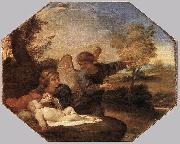
Oil On
Canvas, Real Flavor of Old Masters
|
Andrea Sacchi
|
|||
|
|
|||
| 1559-1661 Italian Andrea Sacchi Gallery As a young man, Sacchi had worked under Cortona in Castel Fusano (1627-1629). But in a set of public debates later developed in the Roman Artist's Guild, Accademia di San Luca, he strongly criticized Cortona's exuberance. In particular, Sacchi advocated that since a unique, individual expression needs to be assigned to each figure in a composition, a painting should not consist of more than about ten figures. In a crowded composition, the figures would be deprived of individuality, and thus cloud the particular meaning of the piece. In some ways this is a reaction against the zealous excess of crowds in paintings by men such as Zuccari of the prior generation, and by Cortona among his contemporaries. Simplicity and unity were essential to Sacchi. Cortona argued that large paintings were more like an epic, that could avail themselves of multiple subplots. The encrustation of a painting with excess decorative details, including melees of crowds, would represent "wall-paper" art rather than focused narrative. Among the partisan's of Sacchi's argument for simplicity and focus were his friends, the sculptor Algardi and painter Poussin. The controversy was however less pitched than some suggest, and also involved the dissatisfaction that Sacchi and Albani, among others, shared regarding the artistic depiction of low or genre subjects and themes, such as preferred by the Bamboccianti and even the Caravaggisti. They felt that high art should focus on exalted themes- biblical, mythologic, or from classic history. Sacchi, who worked almost always in Rome, left few pictures visible in private galleries. He had a flourishing school: Poussin and Carlo Maratta were younger collaborators or pupils. In Maratta's large studio, Sacchi's preference for grand manner style would find pre-eminence among Roman circles for decades to follow. But many others worked under him or his influence including Luigi Garzi, Francesco Lauri, Andrea Camassei and Giacinto Gimignani. Sacchi's own illegitimate son Giuseppe, died young after giving very high hopes. Sacchi died at Nettuno in 1661. | |||
|
|
|||
|
|
Hagar and Ishmael in the Wilderness new25/Andrea Sacchi-797648.jpg Painting ID:: 90653 Visit European Gallery |
ca. 1630(1630) Medium oil on canvas Dimensions 75.6 x 92 cm (29.8 x 36.2 in) cjr | |
Height Width |
INS/CM |
||







